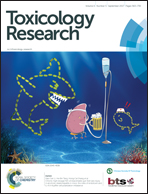Mitochondrial impairment and oxidative stress mediated apoptosis induced by α-Fe2O3 nanoparticles in Saccharomyces cerevisiae†
Abstract
In this study, the potential toxicity of α-Fe2O3-NPs was investigated using a unicellular eukaryote model, Saccharomyces cerevisiae (S. cerevisiae). The results showed that cell viability and proliferation were significantly decreased (p < 0.01) following exposure to 100–600 mg L−1 for 24 h. The IC50 and LC50 values were 352 and 541 mg L−1, respectively. Toxic effects were attributed to α-Fe2O3-NPs rather than iron ions released from the NPs. α-Fe2O3-NPs were accumulated in the vacuole and cytoplasm, and the maximum accumulation (3.95 mg g−1) was reached at 12 h. About 48.6% of cells underwent late apoptosis/necrosis at 600 mg L−1, and the mitochondrial transmembrane potential was significantly decreased (p < 0.01) at 50–600 mg L−1. Biomarkers of oxidative stress [reactive oxygen species (ROS), superoxide dismutase (SOD), catalase (CAT) and glutathione peroxidase (GPx)] and the expression of apoptosis-related genes (Yca1, Nma111, Nuc1 and SOD) were significantly changed after exposure. These combined results indicated that α-Fe2O3-NPs were rapidly internalized in S. cerevisiae, and the accumulated NPs induced cell apoptosis mediated by mitochondrial impairment and oxidative stress.



 Please wait while we load your content...
Please wait while we load your content...